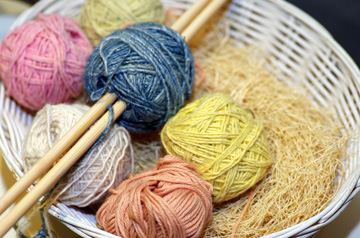Kusaki-zome
 It is said that the number of Japanese traditional colors is more than hundreds. This represents the richness of nature and biodiversity in Japan.
It is said that the number of Japanese traditional colors is more than hundreds. This represents the richness of nature and biodiversity in Japan.
Kusaki-zome, fabric-dyeing with plant juices, has been used since olden times in Japan as a way to incorporate the beautiful colors of nature into lifestyles.
Pick flowers, leaves, stems and roots, extract their colors through decocting, and dye silk or cotton thread. Minerals such as iron or copper are also used for fixing colors. Kusaki-zome is an art piece amalgamating diverse blessings of nature.
It is considered that kusaki-zome has been used for more than one thousand years ago. The Takamatsuzuka Tomb, an ancient circular tomb in Nara Prefecture, which is thought to have been built in the 7th century, is famous for its fresco wall paintings in full color. The women in the painting on the west wall are wearing colorful garments that represent status distinctions; a woman of relatively higher standing is wearing red, and another woman of lower standing is wearing yellow.
As safflower was an expensive plant, only people of higher standing were allowed to wear safflower dyed red garments. As alternatives for safflower and rubia, sappanwood, a native plant of tropical regions, was brought to Japan. The quest for beautiful colors resulted in foreign plants being imported into Japan.
In the Heian Period (794-1185), the color combination, ‘kasane no irome’ (layers of color), was used for dressing by layering different color cloths. Wearing colors and patterns appropriate for each season was considered to be important to maintaining the aesthetics of this period. It is said that the people in this period presumed the personal characters and sensibilities through watching garment colors. Therefore, a lot of descriptions about seasons and colors are found in the literature of the Heian Period, such as The Tale of Genjiand The Pillow Book.
Diverse colors have been adopted for Japanese lifestyles according to the changing in times. In the Edo Period (1603-1868), several books about the materials and techniques of dyeing were published.
In the late Edo Period, ai-zome (dark blue dyed clothes using indigo) created a boom as cotton became available also for citizens. Dark blue from indigo was not soluble in water so the material called sukumo, or dried and fermented indigo leaves, was used. It is said that foreigners who visited Japan in olden times named the color “Japan Blue” because the dyeing method reminded them of Japanese culture.
Seasonal plants found in gardens or mountains are usually used for kusaki-zome. If the same plants are used, the colors differ from season to season. The plant parts used for dyeing and the water quality also influence the colors produced. Ichi-go ichi-e, that treasures meetings with colors – is a form of kusaki-zome.
In the age of the Industrial Revolution, chemical dyes were invented and kusaki-zome was going out of vogue. However, movements for renewing its values have been created recently in many places in Japan.
It is also joyful to create patterns by using tie-dye or stencil-dye. Affections for kusaki-zome works will increase through feeling the colors and fragrances born from natural plants. Why don’t you join a kusaki-zome workshop and try a lifestyle that reminds us of the natural climate?
(Makiko Imai)










